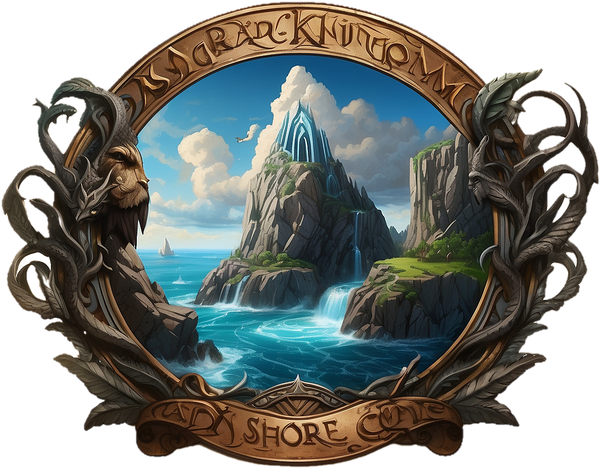Norse Symbols of Protection: Shields for the Soul and Spirit
Share
The Vikings did not believe protection came from strength alone. For every sword they forged, there was a symbol carved. For every enemy faced, there was a rune carried. And for every uncertain journey taken across sea or soul, there was a mark drawn, not of violence, but of shielding.
In Norse culture, symbols were more than decoration. They were spells. Wards. Anchors for the mind. Power etched into bone, wood, or skin, drawn not to conquer others, but to withstand the storm.
Today, we explore these protective symbols. What they meant, how they were used, and why their power endures even now.
The Essence of Protection in Norse Belief
Protection, in Viking eyes, wasn’t just about physical safety. It was spiritual, mental, and even emotional. A warrior feared not just blades, but betrayal. A seer feared not just lies, but fate gone blind. A sailor feared not just storms, but losing his way.
This is why the Norse pantheon includes gods like Frigg, the protector of home and hearth, and Týr, guardian of oaths and truth. Protection was holistic; it guarded your soul as much as your skin.
And so, they turned to symbols. Symbols carved into shields, sewn into clothing, hidden in burial sites, or inked onto flesh. Every shape had weight. Every stroke had a purpose.
The Vegvisir – The Viking Compass
No symbol better captures the Norse idea of spiritual protection than the Vegvisir.
Often called the “Viking Compass,” this symbol is said to help its bearer find their way through rough weather, not just literal storms, but spiritual ones. It is a guide, a map of intention, a ward against becoming lost.
Even today, the Vegvisir resonates with those searching for purpose. It speaks to wanderers, creators, fighters, and anyone walking paths unseen.
Read more about the Vegvisir in our dedicated post:
The Viking Compass: Decoding the Power and Purpose of the Vegvisir
The Aegishjalmur – Helm of Awe
A symbol not of aggression, but of dominance and inner strength.
The Aegishjalmur, or Helm of Awe, was said to grant invincibility in battle and instill fear in enemies. But deeper than that, it was believed to cloak the wearer in spiritual protection, shielding the mind from doubt, fear, and defeat.
It was commonly drawn on the forehead or hidden beneath helmets before battle. Its purpose? To protect the soul from crumbling.
Today, it’s worn by those facing great challenges — not always with swords, but with burdens.
The Troll Cross – Iron Wards Against Evil
Though not found in ancient Viking texts, the Troll Cross is a powerful symbol from later Nordic folklore — a bent iron loop worn to protect against dark magic, curses, and malicious forces.
Its looped shape, resembling an Odal rune, was meant to trap harmful energies and send them back to their source. Blacksmiths would hammer it into amulets or hang it near thresholds, an invisible shield for the everyday home.
Modern believers wear it as a quiet defense — a symbol that asks for nothing but keeps darkness at bay.
Yggdrasil – The World Tree as Anchor
The Norse cosmos was centered around Yggdrasil — the World Tree. It connected the Nine Realms, its branches reaching into every aspect of life, death, and rebirth.
While Yggdrasil wasn’t traditionally a symbol of defense in battle, it was a grounding force. A reminder that all things are part of a vast, interconnected order. In that way, it offered spiritual resilience, the strength to endure, adapt, and keep climbing even after great loss.
In our time of chaos, Yggdrasil is a protector not from swords, but from despair.
Bind Runes – Custom Wards for the Soul
Not all Norse symbols were fixed. Vikings often created bind runes — combinations of two or more runes — to form personal sigils of protection.
One might merge Algiz (defense) with Raidho (journey) for safe travel. Or Sowilo (victory) with Thurisaz (resistance) for strength in adversity.
These were highly individual. Personal spells of survival. Protective anchors against fate’s shifting winds.
In truth, this was the Viking soul laid bare — not seeking conquest, but preservation.
The Spirit of the Wolf – Inner Protection Revealed
Sometimes, protection isn’t something we carry. It’s something we awaken.
In our story, The Wolf Beneath the Skin, a shieldmaiden discovers a lineage of wolf blood hidden deep within her. What she once saw as a curse becomes her defense — not against men, but against the dark within herself.
This tale reminds us that sometimes, the greatest protection is truth. Acceptance of one’s nature. Mastery of one’s wildness.
Read the tale here:
Viking Tales: The Wolf Beneath the Skin
Why These Symbols Still Matter
Modern life may not bring swords to our doors, but it cuts all the same. Doubt, chaos, grief, and fear — these are our foes now.
And just like the Norsemen of old, we need protection. Not just for our homes or our jobs, but for our sense of self.
These symbols — the Vegvisir, Aegishjalmur, Troll Cross, and others — carry ancient resilience. They remind us we’re not the first to feel lost. Not the first to face storms.
But we, like them, can find our way. And symbols like these still light the path.
